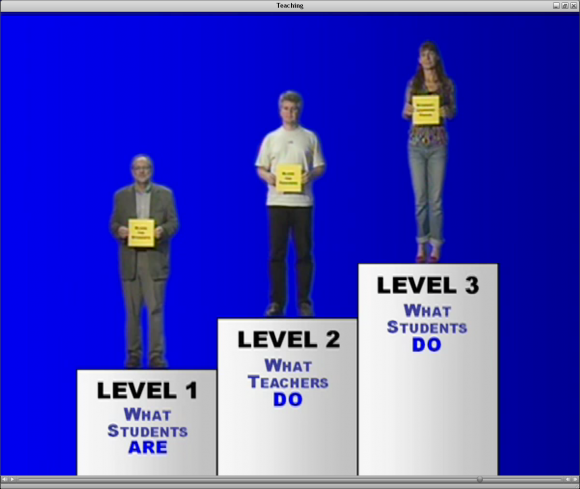Over the summer, I had the chance to sit down and watch some subtle Danish educational humor in the form of Claus Brabrand’s Teaching Teaching & Understanding Understanding (which I’ll call TT/UU for short). The 2006 award-winning production is styled somewhere between an after school special and employee training video – funny, but a very, very, dry funny. My husband, who spent some time in that interesting little country, tells me that’s the Danish way. Thank you, Danes.
Format aside for the moment, the video is highly effective in conveying the core themes of Tasmanian educational psychologist John Biggs‘ “Constructive Alignment“. I probably should have heard of John Biggs before, but I hadn’t and wow is he a fascinating person – fodder for another blog post. I thought it would be fun, though, to respond to the three parts of the TT/UU video in three separate blog posts. There’s so much there to talk about! So here we go.
Part 1 introduces us to Susan and Robert, our protagonists studying Computer Science at University. Susan loves Computer Science, loves going to lecture and thinking more about it outside of class, just for fun. Robert loves making playlists that include Shakira, Britney Spears and Depeche Mode. So how do we teach these two?
 Dr. Biggs’ Three Levels of Thinking About Teaching classify our perspectives on teaching as:
Dr. Biggs’ Three Levels of Thinking About Teaching classify our perspectives on teaching as:
- Level 1: What Students Are
- Level 2: What Teachers Do
- Level 3: What Students Do
If we’re Level 1 thinkers, we focus on what students are – either “good” students or “bad” students. If something’s not working, it’s those “bad” students just being “bad”. Exams help teachers sort students into those two groups. You can guess where Susan and Robert end up.
If we’re Level 2 thinkers, we focus on what teachers do. If something’s not working, it’s because we’re “bad” teachers*. Students are most often thought as passive containers, though in the best case, highly entertained passive containers. Robert’s got some popcorn and a nice big soda.
If we’re Level 3 thinkers, we’re focusing on what students do – before, during, and after their time in the classroom. We want to know about the product of our teaching – you guessed it: the student’s learning outcome.
Before before we talk about Level 3 thinking, we have to understand student understanding. Stay tuned for Danish educational humor, part 2!
*Oh I felt so sorry for the “bad” teacher in this example, stumbling over his fuzzy overheads (6:35). I’ve been there, “bad” teacher! We’ve all been there!



Comments are closed.